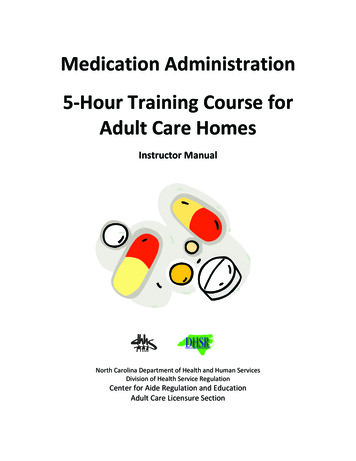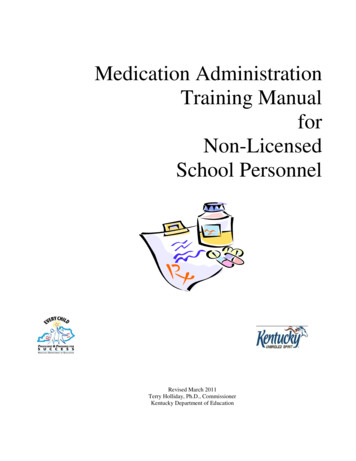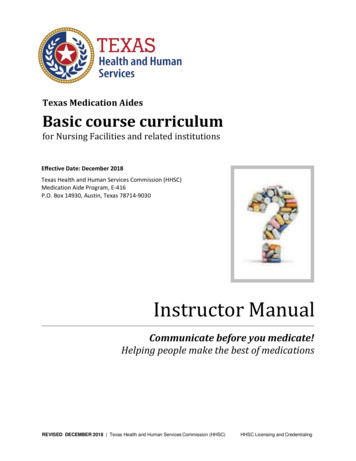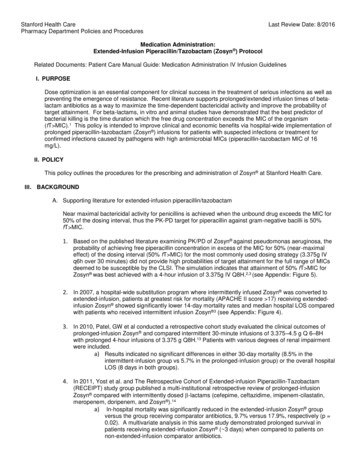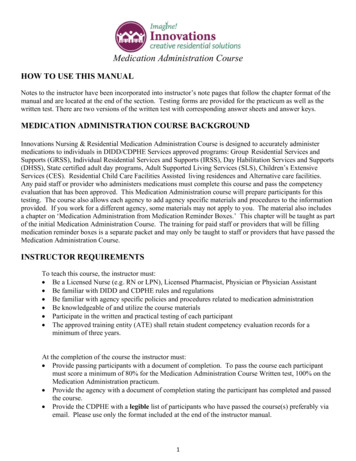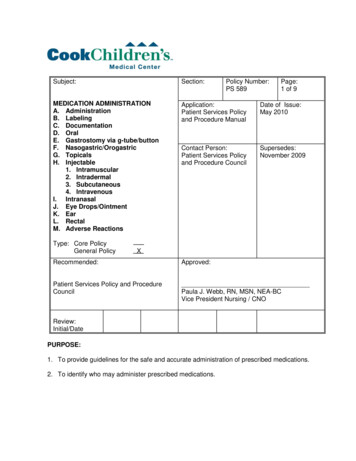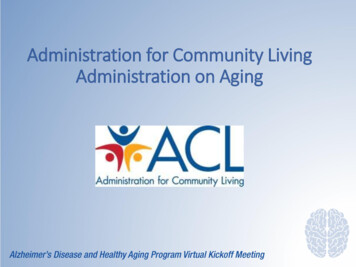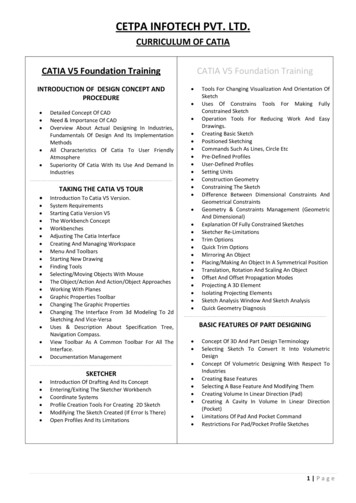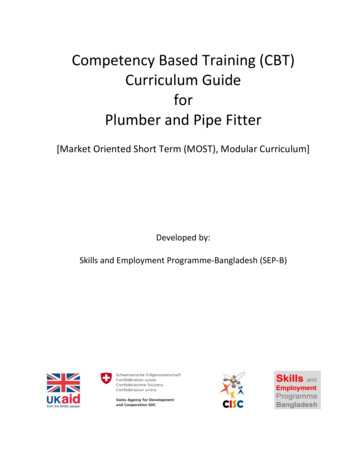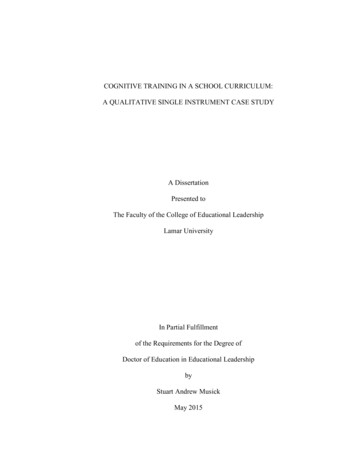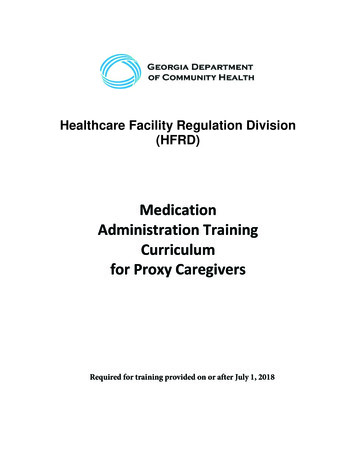
Transcription
Healthcare Facility Regulation Division(HFRD)MedicationAdministration TrainingCurriculumfor Proxy CaregiversRequired for training provided on or after July 1, 2018
Section 1Section 1Basic Medication AdministrationInformation/TerminologyGeorgia Department of Community HealthProxy Caregiver Medication Assistance Training CurriculumEffective July 1, 2018Page 2 of 48
Section 1Section 1 – Basic Medication Administration Information/TerminologyObjectives1.2.3.4.5.Match common medical abbreviations with their meaning.List and describe common dosage forms of medications.List and describe common routes of medication administration.List the six rights of medication administration.Describe what constitutes a medication error and actions to take when a medication error ismade or detected.6. Describe resident’s rights regarding medications – refusal, privacy, respect, and chemicalrestraint.7. Define medication “allergy” and describe responsibility in relation to identified allergies andsuspected allergic reactions.8. Demonstrate the use of medication resources or references. TEACHING TIP: AbbreviationsIf available, locate the approved abbreviation list at the facility and point out this to thestudents HANDOUT #1A: AbbreviationsDistribute a copy of the handout, Abbreviations to each student.Common Abbreviations Abbreviation – a shortened form of a word or phrases Often used in medical and residents’ records, such as physician’s orders Proxy Caregiver must learn abbreviations for terms common to medication administration On the Medication Administration Record (MAR), abbreviations should be spelled out Be aware that abbreviations can lead to mistakes if they are not legible Always check with the supervisor if you have questions about abbreviationsGeorgia Department of Community HealthProxy Caregiver Medication Assistance Training CurriculumEffective July 1, 2018Page 3 of 48
Section 1Section 1 – Basic Medication Administration Information/Terminology TEACHING TIP: Abbreviations HandoutTell students: These are abbreviations that you will see frequently when you give medications to yourresidents You should learn these abbreviations HANDOUT #1B: Common Routes of Medication AdministrationDistribute a copy of the handout on Common Routes of Medication Administration to eachstudent. TEACHING TIP: Common Routes of Medication AdministrationReferring to the handout and the content below, discuss the common routes of medicationadministration. Use visual aids if availableCommon Routes of Medication Administration Oral – taken by the mouth and swallowed Buccal – placed between cheek and gum Sublingual – placed under the tongue Eye – placed in the pocket of the eye created when the lower eyelid is gently pulled down Ear – placed in the ear canal created when the external ear is pulled up and back Nasal – placed in the nostril Inhalant – inhaled into the lungs Transdermal – placed and affixed to the skin Topical – applied to the skin or hair Vaginal – inserted into the vagina Rectal – inserted into the rectum Subcutaneous– injected into the fat with a syringe HANDOUT #1C: Common Dosage Forms of MedicationsDistribute a copy of the handout on Common Dosage Forms of Medications to each student. TEACHING TIP: Common Dosage Forms of MedicationsReferring to the handout and the content below, discuss the common dosage forms ofmedication administration. Use visual aids if availableGeorgia Department of Community HealthProxy Caregiver Medication Assistance Training CurriculumEffective July 1, 2018Page 4 of 48
Section 1Section 1 – Basic Medication Administration Information/TerminologyCommon Dosage Forms of Medications Tableto Hard, compressed medication in round, oval, or square shapeo Some have enteric coating or other types of coatings, which delay release of the drugand can not be crushed or chewed Capsuleo In a gelatin container that may be hard or softo Dissolves quickly in stomach Liquid – different types of liquid medicationso Solution – a liquid containing dissolved medicationo Suspension – a liquid holding undissolved particles of medication that must be shakenbefore measuring and administering to residento Syrup – a liquid medication dissolved in a sugar water to disguise its tasteo Elixir – a sweet alcohol based solution in which medications are dissolved Suppositoryo Small solid medicated substance, usually cone-shapedo Melts at body temperatureo May be administered by rectum or vaginao Refrigerate as directed by manufacturer Inhalanto Medication carried into the respiratory tract using air, oxygen or steamo Inhalants may be used orally or nasally Topical – applied directly to the skin surface. Topical medications include the following:o Ointment – a semisolid substance for application of medication to the skin or eyeo Lotion – a medication dissolved in liquid for applying to the skino Paste – a semisolid substance thicker and stiffer than an ointment containingmedicationso Cream – semisolid preparation holding medication so it can be applied to skino Shampoo – liquid containing medication that is applied to the scalp and hairo Patches (transdermal) – medication encased in a round, square, or oval disc that isaffixed to the skino Powder – fine, ground form of medication that may be used to be swallowed, or may beused as on the skin for rasheso Aerosol sprays – solution that holds the medication suspended until it is dispensed in theform of a mist to spray on the skin Teaching Tip: Introduction to Equipment and Supplies Used During Administration ofMedicationShow examples of supplies and equipment used during medication administrationGeorgia Department of Community HealthProxy Caregiver Medication Assistance Training CurriculumEffective July 1, 2018Page 5 of 48
Section 1Section 1 – Basic Medication Administration Information/TerminologyEquipment and Supplies Used During Administration of Medication Medication cart MAR for each resident Soufflé cups for oral medications in pill or capsule form Calibrated plastic cups and oral syringes or droppers for oral liquid medications Alcohol wipes for use with injections Insulin syringes for use with insulin administration Sharps equipment Band-Aids for use with injections Lubricant for use with suppositories Blood pressure cuff, stethoscope, blood glucose meter as needed Gloves to use when coming into contact with mucus membranes (administering vaginal orrectal suppositories) and blood/body fluids (administering injections) Water cup and water for resident to drink when taking oral medications Soap/water/paper towels or alcohol-based hand rubs to use before preparingmedications/before administration of medication to each resident/after administration ofmedication to each resident Food, such as applesauce or pudding to use when administering crushed medications HANDOUT #1D: Six Rights of Medication AdministrationDistribute a copy of the handout on Six Rights to each student.Referring to the handout and the content below, discuss the Six Rights of MedicationAdministrationSix Rights of Medication Administration A method used during medication administration to safeguard the residents; beforeadministering the medication the Proxy Caregiver must ask self six questions – Am I givingthe medication to the right resident? Am I giving the right medication? Am I giving the rightdose? Is this the right route? Is this the right time? Have I done the right documentation?o Right resident – identify resident to assure you are giving the medication to the residentwho is supposed to receive the medication and using procedure required by the facility,such as photo on the MAR, asking a resident his/her name, etco Right medication – the name of the medication ordered by the physician; always use thethree checkso Right dose – the amount of medication orderedo Right route – the method of medication administrationo Right time – when the resident is ordered to receive the medicationo Right documentation – the process of writing down that a medication was administeredto the resident on the MAR and writing down if a medication ordered was notadministered and the reason it was not administeredGeorgia Department of Community HealthProxy Caregiver Medication Assistance Training CurriculumEffective July 1, 2018Page 6 of 48
Section 1Section 1 – Basic Medication Administration Information/Terminology HANDOUT #1E: Medication ErrorsDistribute a copy of the handout on Medication Errors to each student.Referring to the handout and the content below, discuss the definition of medication errors,examples and the Proxy Caregiver’s roleMedication Errors Describe – occurs when the administration of a medication is not as prescribed by the doctoror prescribing practitioner; when a medication is administered in any way other than how itwas prescribed Exampleso Omissionso Administration of a medication not prescribed by the prescribing practitionero Wrong dosage, wrong time, or wrong routeo Crushing a medication that shouldn’t be crushedo Documentation errors Proxy Caregiver’s roleo Understand the facility’s medication error policy and procedure or know where tolocate ito Recognizes when a medication error is madeo Understands importance of acting quickly to report and correct medication errors tohelp prevent more serious problemsMedication Administration and Resident’s Rights – Importance and Examples Respect – how the resident is addressedo Do not interrupt resident while eating for the administration of medications, such as oralinhalers and eye dropso Do not awaken resident to administer a medication that could be scheduled oradministered at other timeso Inform resident about the procedure that is about to be performedo Answer resident’s question about medication Refusal – resident has the right to refuse medicationso Never force a resident to take a medicationo Follow the facility’s policy and procedure when a resident refuses medications (policyand procedure ensures that physician is notified in a timely manner based on resident’sphysical and mental condition and the medication Privacy – being away from the publico Knock on closed doors before enteringo Do not administer medications when resident is receiving personal care or in bathroomGeorgia Department of Community HealthProxy Caregiver Medication Assistance Training CurriculumEffective July 1, 2018Page 7 of 48
Section 1Section 1 – Basic Medication Administration Information/Terminology o Do not administer an injection outside resident’s room if the resident receiving theinjection or other residents present are offended by thiso Do not administer medications outside the resident’s room that require privacy andremoval of clothing, such as vaginal and rectal administrations, dressing changes andtreatmentsChemical restraint – means a drug that is used for discipline or convenience and not used totreat a medical symptomo Do not administer medications, especially psychotropics, for staff convenience HANDOUT #1F: Resident’s Refusal to Take MedicationsDistribute a copy of the handout on Reasons for Resident’s Refusal to Take Medications to eachstudent.Medication Allergy A reaction occurring as the result of an unusual sensitivity to a medication or othersubstanceo May be mild or life-threatening situationo May include rashes, swelling, itching, significant discomfort or an undesirable change inmental status, which should be reported to physician Role of Proxy Caregivero Should understand that information on allergies should be reported to the pharmacy andphysician and this information is recorded in the resident’s recordo Upon admission, important to document any known allergies or if there are no knownallergies should also be documentedo Provide immediate emergency care if severe rash or life-threatening breathingdifficulties occurRecognizing and Reporting Side Effects Resident may have various side effects from taking certain medications Side effects include but are not limited to the followingo Change in behavioro Change in alertnesso Change in eating or swallowingo Change in mobilityo Skin rashes When there is a change in the resident, follow the facility's policy on what to do and whoto notify, which may includeo Notifying the supervisor, health care professional and/or physiciano NOT administering a medication when there is a change in the resident without contactwith the resident’s physicianGeorgia Department of Community HealthProxy Caregiver Medication Assistance Training CurriculumEffective July 1, 2018Page 8 of 48
Section 1Section 1 – Basic Medication Administration Information/Terminology Observation of the resident is an important step in the cycle of medication administrationo Resident’s physician and health care providers often depend on the observations ofdirect care staff when evaluating residentso Also depend on Proxy Caregivers to observe residents for both desired and undesiredeffect of medicationTo insure safe care, the Proxy Caregiver must be taught how to observe and report changes inthe resident physical and/or mental status. The Proxy Caregiver must know what to report, towhom it should be reported, and when and how to report observations TEACHING TIP: Medication Resources or ReferencesLocate and demonstrate use of the following written materials housed at the facility: medicationresources, reference books, manuals and/or pharmacy information sheets; and policy andprocedure manuals, particularly the sections that address medication administration. Resourceswritten for non-health professionals are recommended for use by Medication Aides instead ofreferences written for health professionals, such as The Physician’s Desk Reference(PDR)Examples of Resources to use: The Pill Book Mass Market Paperback by Harold M. Silverman (Author) The PDR Pocket Guide to Prescription Drugs [Mass Market Paperback] PDR Staff (Author) Complete Guide to Prescription & Nonprescription Drugs Paperback – by H. Winter Griffith(Author) ACTIVITIES: Medication Resources or ReferencesRequire each student to Look up at least three unique medications commonly ordered for residents in amedication resource/reference book, such as Lasix, Coumadin, and Synthroid View the table of contents in the policy and procedure manuals at the facility and look upand read all facility policies/procedures regarding medication administrationProceed to Section #2Georgia Department of Community HealthProxy Caregiver Medication Assistance Training CurriculumEffective July 1, 2018Page 9 of 48
Section 2Section 2Medication AdministrationGeorgia Department of Community HealthProxy Caregiver Medication Assistance Training CurriculumEffective July 1, 2018Page 10 of 48
Section 2Section 2 – Medication AdministrationObjectives1. Demonstrate correct infection control concepts during medication administration.2. Compare and contrast the documentation of routine medication administration and PRNmedication administration.3. Recognize the need to document in the resident’s record when necessary.4. Describe correct documentation of medication.5. List commonly used abbreviations and terminology related to medication administration.6. Demonstrate proficiency in reading a medication label.7. Use the Six Rights to administer oral, eye, ear, nasal, inhalant topical medications andsubcutaneous injections – Right RESIDENT, Right MEDICATION, Right DOSE, Right ROUTE,Right TIME, and Right DOCUMENTATION.8. Demonstrate the use of the Medication Administration Record (MAR).9. Identify proper action to take when special circumstances occur in relation to medicationadministration.ContentImportant Infection Control Concepts During Administration of Medication Use sanitary technique when pouring or preparing medications into appropriate container Do not touch or handle medications, but pour medication from the original medicationcontainer into a new, appropriate medication container in the presence of the resident; givethe new container to residentNeveruse your own hands to administer medications and never require resident to have to use his/her own hands to receive medicationsStandard Precautions Observe Standard Precautions Wear gloves when there may be exposure to bodily fluids or mucus membranes, such as thevagina, rectum, inside of the nose, and the eyes Wash hands with soap and water; or with an alcohol-based hand rub if hands are not visiblysoiled or if there has been no contact with bodily fluids Wash hands before and after removal of gloves Wash hands before and after using shared medical equipment Gloves should be worn and hand hygiene must be performed when transdermal products,i.e., Nitroglycerin or Durgesic patches, are applied or removedSyringes, Needles and Vials Cleanse the tops of medication vials with 70% alcohol before inserting a needle into the vial Never administer medications from the same syringe to multiple patients, even if the needleis changed Do not reuse a syringe to enter a medication vial or solutionGeorgia Department of Community HealthProxy Caregiver Medication Assistance Training CurriculumEffective July 1, 2018Page 11 of 48
Section 2 Section 2 – Medication AdministrationDo not administer medications from single-dose or single-use vials, ampules, bags or bottlesto more than one residentMulti-dose vials should be used for a single resident, whenever possibleDispose of used syringes and needles at the point of use in a sharps container that isclosable, puncture-resistant, and leak-proofNever recap, bend or break needles TEACHING TIP: Alcohol-based Hand RubLocate alcohol-based hand rub product used in the facility. Read manufacturer’s directions todetermine amount of product needed. Show alcohol-based hand rub product to students,pointing out the amount of product requiredACTIVITY #1: Hand Positions During Hand Hygiene (Optional)Distribute WHO’s How to Hand Rub? How to Hand Wash? Activity Handout #1 to studentsWhile referring to the WHO Hand Rub/Hand Wash Handout, talk through and demonstrate eachhand motion during hand hygiene and notice to make sure the students are following along andcopying what is being demonstrated: Rub hands, palm to palm Rub right palm over left back of hand with interlaced fingers; and then switch Rub palm to palm with interlaced fingers Rub backs of fingers to opposite palm with fingers interlocked In a rotational motion, rub left thumb while clasping in right palm; and then switch In a rotational backwards and forwards motion, rub left palm with clasped right fingers; andthen switch Grasp right wrist with left hand; and then switchYour Hands – Other Important Points There are other things you can do to prevent the spread of infection Fingernailso Keep nails short and cleano Do not wear fake nails, gel nails or nail extensions, because they can hide harmful germs Jewelryo Leave at home because harmful germs can stick to jewelryThe student will have to demonstrate competency with Hand Wash and Hand RubGeorgia Department of Community HealthProxy Caregiver Medication Assistance Training CurriculumEffective July 1, 2018Page 12 of 48
Section 2Section 2 – Medication AdministrationGloves Most common type of Personal Protective Equipment worn with medication administration Descriptiono Non-sterile (clean) gloves made using different materials, such as vinyl or latex; if allergicto latex, wear non-latex gloveso Come in different sizesGloves – Rules Should be worn once and then thrown away When wearing gloves, always work from (or touch) a clean area, before touchingcontaminated (or dirty) area Change gloves if hands are going to move from a body part that is contaminated (dirty) to abody part that is not contaminated (clean) Change gloves right away if dirty or torn Take gloves off carefully and do not touch skin or clothes with dirty sides of gloves Do not touch anything with dirty gloves that anyone may touch without gloves, like adoorknob Should
o Should understand that information on allergies should be reported to the pharmacy and physician and this information is recorded in the resident’s record o Upon File Size: 1MBPage Count: 48
